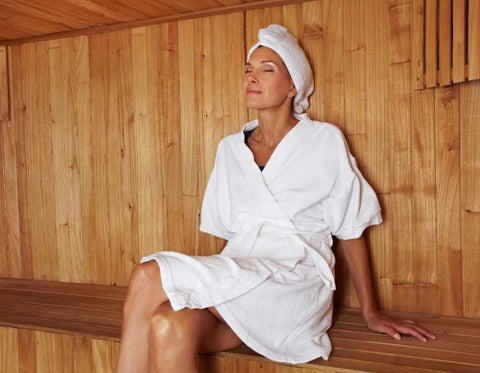What Does a Sauna Do for Your Skin? The Surprising Benefits
Stepping into a heated sauna and letting your body slowly sweat out toxins sounds quite relaxing...but did you know using a sauna offers some truly benefits for your skin?
As more health-conscious consumers invest in building backyard saunas or visiting luxury spas with state-of-the-art steam rooms, interest in understanding all that sweating can do has reached a fever pitch.
And there's a good reason for this growing curiosity. Industry reports have shown that the global sauna and steam room market is poised to grow at an impressive CAGR of 4.79% from 2022 to 2030. This increasing market demand ties directly to more research and awareness of all the ways that routines like sauna use can support our health, especially for key visible areas like our skin’s appearance and anti-aging abilities.
When it comes to achieving smooth, healthy, and youthful-looking skin over time, your average sauna session offers far more rewards than one might expect. Let’s take a closer look at exactly how spending concentrated time sweating in high heat and humidity impacts everything from your complexion to moisturization and beyond.

How Saunas Work
Saunas utilize dry or wet heat sessions to induce therapeutic sweating and provide potential sauna health benefits.
Traditional Finnish saunas use dry heat sessions, with wooden rooms heated by a stove. Traditional sauna have temperatures typically reaching 80-100°C. Steam rooms provide wet heat sessions, with humidity levels approaching 100% and temperatures around 45-50°C.
During a sauna, the heat causes blood vessels to dilate, increasing blood flow throughout the body. As heat and humidity increase, the body's nervous system senses changing conditions and the heart rate goes up as blood moves toward the skin and subcutaneous tissue. This allows the body to cool itself through sweating and radiating heat via your skin's surface.
Sweat is primarily composed of water with traces of urea, sodium, potassium, and other electrolytes. When sweat evaporates from skin surfaces, it supports the release of dirt, shed dead skin cells, excess sebum, and trapped bacteria. The average person can sweat out nearly a liter per hour in a sauna session.
This flushing-out effect provides a deep cleanse for skin and pores while removing toxins from the body. Increased blood flow also benefits cell nutrition and waste removal. Skin surfaces receive more oxygenated blood during active heating, which can aid tissue regeneration and healthy cell turnover.
Direct Skin Effects

The high heat and humidity of saunas provide numerous direct effects that benefit skin health and appearance. The flushing action of sweating opens clogged pores deeply, clearing out debris and unclogging areas prone to blackheads or breakouts. The deep cleansing induced by sauna use can aid those struggling with acne.
In addition to dirt and bacteria, toxic chemicals from pollution in our environments build up on our skin over time. Sweating liberates these trapped toxins and allows natural skin respiration.
Facial steams utilize similar principles, closed heat and humidity to open pores and release impurities before extractions. Sweat's antimicrobial properties make the skin's ecosystem less hospitable for bacteria linked to common dermatological issues.
The increased blood circulation to skin surfaces allows for better nutrition of skin cells and waste removal. Active heating triggers the body's inflammation and tissue repair responses.
Collagen production increases to heal damage related to aging, UV exposure, or scarring. Growth factors and skin-firming collagen proliferate as cells regenerate at faster rates. These skin glow and anti-aging response promotes elasticity and youthful tone when induced consistently.
RELATED TO: Are Saunas Good For Our Skin?
Infrared Saunas Offer Targeted Skin Benefits

Infrared saunas utilize far infrared wavelengths of light to gently heat body tissues safely and effectively. While traditional saunas, steam rooms, and other heat treatments rely on warming skin surfaces, infrared penetrates more deeply and selectively.
Special near, mid, or far infrared wavelengths stimulate subcutaneous cells directly. This allows precise targeting of skin, fat, and muscle layers without overheating more sensitive areas.
Studies show exposure to these rejuvenating infrared wavelengths improves factors contributing to skin’s youthful appearance like collagen growth, tissue oxygenation, and microcirculation.
IR wavelengths also reduce inflammation, cellulite, and stubborn fat while purifying by eliminating toxins and heavy metals. The concentrated skin stimulation of infrared bio-resonance leaves complexions tighter and brighter.
For those struggling with acne scars or textural issues from years of clogged pores and sebaceous gland problems, infrared saunas can provide transformative results. The combination of sweat’s deep cleansing with infrared’s unique tissue stimulation clears current breakouts while also minimizing past acne damage. Those frustrated with traditional acne treatments may find infrared sauna sessions more effective for their specific skin struggles.
Anti-Aging & Long-Term Skin Health Changes

While the direct effects of sweating provide clearer and healthier skin, consistent long-term home sauna use can support lasting anti-aging changes.
The increase in collagen production is a major way that repetitive exposure to sauna heat promotes youthful tone and the reduction of fine lines.
As part of the inflammation process induced by heating, antioxidant activity increases as cells try to counteract damage. The consistent boost in antioxidants helps strengthen skin cells over months and years, protecting DNA from breakdown.
Heat exposure promotes tissue adaptation responses, making cell structures more stable and less prone to age-related decline.
Research also indicates sauna use may extend epidermal stem cell vitality over decades. These long-living cells are crucial for the regeneration of healthy new tissue. This preserves youthful skin structure instead of abnormal changes.
Consistent sweating also gradually destroys Propionibacterium acnes bacteria linked to inflammatory acne. This creates lasting reductions in breakouts for some individuals.
The bacteria balance shift continues improving texture, acne scars, and tone. For teens struggling with hormonal acne, developing a regular sauna sweating habit may provide lasting counteraction.
Over months and years, sauna users report substantial anti-aging changes reversing sun damage, cellulite, acne scarring, and wrinkles. Combining sauna sessions with healthy lifestyle choices may maximize these regenerative effects.
Additional Sauna Benefits

Using saunas frequently can also provide potential benefits for common skin conditions like:
Eczema: The sweating process helps flush out irritants, allergens, and microbes while supporting moisture retention capacities in skin tissues. This assists in clearing flare-ups for sensitive skin.
Psoriasis: Heating and sweating appear to accelerate skin cell turnover and support the regeneration of healthy tissue instead of plaques. This may gradually reduce outbreaks.
Fungal infections: The antimicrobial environment induced on skin surfaces inhibits fungal growth and helps clear infections. Heat exposure can also bolster immune functioning.
Holistic Health Ties
While a sauna is good for your skin, true dermatological health relies heavily on whole-body wellness. Sauna use supports this wider mind/body health through:
Relaxation: The meditative, screen-free, and present-moment awareness during sauna sessions provides potential mental clarity and stress relief. This assists overall well-being.
Detoxification: Sweat flushes out many toxins and bacteria from skin tissues and also bodily systems. This prevents internal contamination that could indirectly affect the skin.
Improved Circulation of Blood: The heat and light stimulation of infrared saunas dilates underlying blood vessels, boosting circulation to skin tissues and the entire body. This temporarily lowers blood pressure while delivering essential nutrients, oxygen and hydration to skin cells at faster rates.
Combining sauna therapy with balanced nutrition, movement, mindfulness, and topical skin treatments enhances results further. A holistic lifestyle approach maximizes regenerative capacities from cellular to mental levels.
Optimizing Your Sauna Session: Finding Your Sweat Sweet Spot

When first beginning sauna therapy, start low and go slow. Sessions should begin at 10-15 minutes then slowly increase in 5-10 minute increments as your body adapts.
Listen closely to internal cues rather than pushing excessively. The goal is controlled, therapeutic perspiration not extreme overheating.
As your heat tolerance improves, most find sessions of 30-45 minutes 1-3 times per week provide skin benefits without overload. Tracking details like duration, temperature, and humidity levels can help customize your perfect regimen.
Consider wearing a fitness tracker to monitor intensity via heart rate and calorie burn.
Hydration is Key
Dehydration is a top risk in sauna use. Drink at least 16 oz of electrolyte-rich fluid before sessions. Many enjoy coconut water post-sauna to replenish nutrients lost through sweat.
Stay hydrated during the heat exposure by keeping a water bottle nearby to sip frequently. After sauna time, avoid alcohol and caffeine which may subvert hydration.
Set the Mood
Enhance relaxation by diffusing essential oils like eucalyptus or creating a customized playlist to listen to during sessions. Warm lighting rather than bright fluorescents also promotes rest.
Focus on your breath and body to remain centered in the present moment rather than obsessing overtime limits.
Consistency Over Intensity
Sporadic intense sauna experiences may provide novelty but not lasting skin change. Make sessions a consistent habit but avoid overdoing length or temperature settings to a degree that feels unpleasurable.
Monitor energy levels and mood outside the sauna - fatigue, irritability or dizziness means it’s time for a break.
Is it safe to use a sauna?
Yes, for most healthy adults sauna use is safe in moderation. Start with 10-15 minutes then slowly work your way up to 30-45 minutes per session.
Stay hydrated, avoid alcohol/medications before use, and leave immediately if you feel dizzy or unwell. Those with heart conditions, pregnant women, and young children should consult doctors first.
Will a sauna help me lose weight?
You may lose some water weight from sweating off fluid during sauna sessions. However, high heat exposure alone will not burn large amounts of calories or fat compared to traditional exercise.
Any lost weight is usually rapidly regained when you rehydrate. Consider saunas for other health and appearance benefits but not sustainable weight loss.

What temperature should I set the sauna to?
A typical dry sauna temperature range is 80-100°C, while wet steam rooms stay around 45-50°C. Start in the lower part of these spectrums when beginning then increase heat based on personal preference and heat tolerance gained over time.
Pay attention to how your body responds rather than competitively cranking temperatures dangerously high.
How often should I use a sauna?
Experts recommend sauna use 2-3 times per week as part of a self-care routine. Stick with a consistent schedule rather than drastic highs and lows in session frequency.
Consistency over 6-12 month periods provides the best skin and health results from thermal therapy.
Do I need to shower before/after using a sauna?
Pre-sauna showers are not strictly necessary but can remove dirt, dead skin cells, makeup, and fragrances from your skin to maximize deep cleansing sweat benefits.
Post-sauna showers feel refreshing and cool your body temperature down after high heat. Gently cleanse skin with a cold shower after sessions but avoid abrasive scrubs. Apply moisturizers to counter dryness.

In Summary
After exploring the various ways saunas impact the skin, the multitude of potential health benefits should seem far from surprising. The combination of deep cleansing sweat, increased circulation, tissue regeneration responses, and bacteria balance shifts add up to holistic skin rejuvenation over time.
While a single sauna session provides temporary aesthetic improvements, the real magic lies in cumulative change. Making regular sweat sessions part of your self-care routine ensures compounding gains for youthful tone and clarity. Just be sure to listen to your body, stay hydrated, and don’t overdo initial intensity or durations.
Keep in mind that saunas boost skin health but cannot replace proper skincare. Continue using targeted serums, SPF protection, and gentile cleansing paired with sweat therapy rather than expecting heat alone to do all the work. Think of saunas as amplifying and supporting your existing regimen.
The next time you find yourself with tired skin needing a reset, consider booking a sauna room session at your gym, or day spa or even purchasing passes for a float studio’s infrared pods. Or simply turn up the dial on your home sauna before unwinding with journaling, meditating, or an organic clay mask.
However you choose to sweat it out, just commit to consistency and your skin is sure to thank you!
